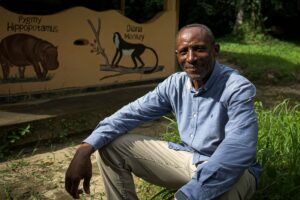Monday, October 21, 2024
Cali, Colombia
The United Nations Conference on the Conservation of Nature kicked off in Colombia on Monday, a two-week marathon to try to unlock the resources needed to meet its goal of halting humanity’s destruction of biodiversity by 2030.
Colombian Environment Minister Susana Muhamad opened the proceedings by taking over the presidency of this 16th conference of the UN Convention on Biological Diversity, at a first plenary session opened by a prayer to “Pachamama”, the Earth-Sea, delivered by members of one of the country’s 150 indigenous peoples.
This Biodiversity COP, the largest ever organized with 23,000 registrants, is being held under tight security in Cali, capital of a southwestern province on high alert due to threats from guerrillas at war with the government.
Some 11,000 Colombian police officers and soldiers, backed up by UN and US security personnel, are reinforcing security in Cali, where 140 ministers and a dozen heads of state are expected at the end of October.
Susana Muhamad listed her five priorities for “a successful COP”, citing first and foremost “the importance of recognizing the work of indigenous peoples and local communities”, whose territories conserve the greatest treasures of biodiversity.
“It’s about recognizing the political power of those who are on the front line of the biodiversity crisis and on the front line of solutions” and ‘we need all the tools derived from humanity’s ancestral experience’, she defended.
“We are nature,” declared the Colombian minister. “And it’s from this deep, almost spiritual sense of humanity that we can create this common goal that should be as important, if not more so, than the energy transition and decarbonization” of the economy, addressed by the more high-profile COP climate goods (the next of which, COP29, opens in three weeks’ time in Azerbaijan), despite calls to reconcile the climate and nature crises.
– “Underfunded” –
“The planet has no time to lose”, ‘Cali 2024 could be a light in a very dark world’, she encouraged delegates from the 196 member countries (excluding the USA) of the Convention.
On Sunday, they were urged by UN chief Antonio Guterres to “move from words to deeds” because “we’re not on the right track”.
At COP15 two years ago, the historic “Kunming-Montreal” agreement was adopted, a roadmap designed to “halt and reverse” by 2030 the destruction of land, oceans and living species essential to humanity.
Countries had pledged to present a “national biodiversity strategy” by COP16, reflecting their share of efforts to meet the 23 global targets set: protect 30% of land and sea, restore 30% of degraded ecosystems, halve the use of pesticides and the rate of introduction of invasive alien species, mobilize $200 billion a year for nature, etc…
To date, however, only 34 countries have fulfilled their commitment to submit complete strategies. And 107 have submitted “national targets”, i.e. commitments on all or part of the objectives, according to Astrid Schomaker, Executive Secretary of the CBD.
COP16 must also present details of a mechanism for monitoring global efforts, with indisputable indicators, in order to hold countries accountable and prepare a credible official progress report for COP17 in 2026.
And negotiate a system for sharing the profits made by rich-country companies, led by cosmetics and pharmaceuticals, from genetic data derived from plants and animals conserved by developing countries.
But the sinews of war will above all be financial: “We all agree that we are underfunded for this mission, that we need other sources of financing”, declared the COP16 president, urging the developed countries, which are supposed to provide 20 billion dollars a year by 2025, to announce new commitments.
The NGO Greenpeace, in a report unveiled on Monday, was more alarmist, estimating that at the current rate of progress, the goal of protecting 30% of the oceans by 2030 will not be achieved before the end of the century.
Since the 1992 Rio Earth Summit, when the CBD was created, only 8.4% of the oceans have become marine protected areas (MPAs). And only 2.7% of the oceans are “strongly” protected from human activities, says Greenpeace.
“Governments must accelerate the pace of ratifications to bring the global oceans treaty to life by 2025”, ‘the only way’ to meet the 30% target, said Megan Randles, Greenpeace UK policy advisor, in Cali.
Humaniterre with AFP





